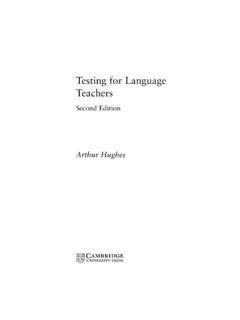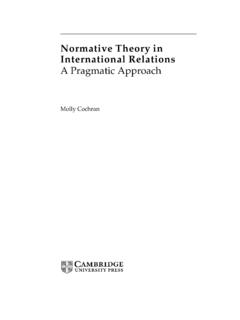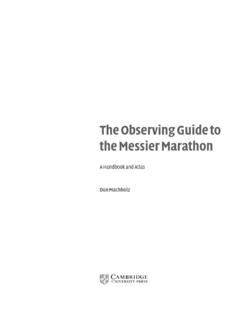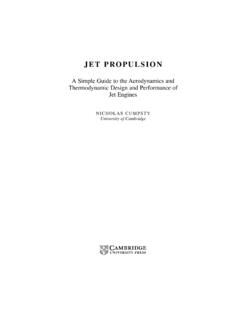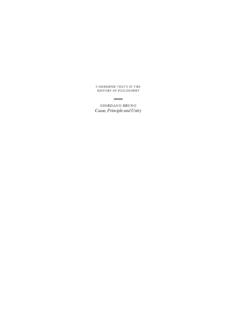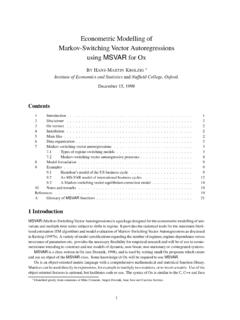Transcription of Introductory Econometrics for Finance
1 Introductory Econometrics for Finance Chris Brooks The ISMA Centre, University of Reading published by the press syndicate of the university of cambridge The Pitt Building, Trumpington Street, Cambridge, United Kingdom cambridge university press The Edinburgh Building, Cambridge CB2 2RU, UK. 40 West 20th Street, New York, NY 10011-4211, USA. 477 Williamstown Road, Port Melbourne, VIC 3207, Australia Ruiz de Alarco n 13, 28014 Madrid, Spain Dock House, The Waterfront, Cape Town 8001, South Africa . C Chris Brooks 2002. This book is in copyright. Subject to statutory exception and to the provisions of relevant collective licensing agreements, no reproduction of any part may take place without the written permission of Cambridge University Press. First published 2002. Printed in the United Kingdom at the University Press, Cambridge Typefaces Swift pt. and Franklin Gothic System LATEX 2 [TB]. A catalogue record for this book is available from the British Library Library of Congress Cataloguing in Publication data Brooks, Chris Introductory Econometrics for Finance / Chris Brooks.
2 P. cm. Includes bibliographical references and index. ISBN 0 521 79018 2 (hardback) -- ISBN 0 521 79367 X (paperback). 1. Finance -- Econometric models. 2. Econometrics . I. Title. HG173 .B76 2002. 332 .01 5195 -- dc21 2001037930. ISBN 0 521 79018 2 hardback ISBN 0 521 79367 X paperback Contents List of figures page xii List of tables xv List of boxes xviii List of screenshots xx Preface xxi Acknowledgements xxv 1 Introduction 1. What is Econometrics ? 1. Is financial Econometrics different from economic Econometrics '? Some stylised characteristics of financial data 2. Types of data 4. Returns in financial modelling 6. Steps involved in formulating an econometric model 8. Some points to consider when reading articles in the empirical financial literature 10. Outline of the remainder of this book 11. 2 Econometric packages for modelling financial data 15. What packages are available? 15. Choosing a package 16. Accomplishing simple tasks using the two packages 17. WinRATS 18. EViews 31.
3 Further reading 39. Appendix: economic software package suppliers 40. 3 A brief overview of the classical linear regression model 42. What is a regression model? 42. Regression versus correlation 43. v r vi Contents Simple regression 43. Some further terminology 52. The assumptions underlying the classical linear regression model 55. Properties of the OLS estimator 56. Precision and standard errors 58. An introduction to statistical inference 64. Generalising the simple model to multiple linear regression 82. The constant term 83. How are the parameters (the elements of the vector). calculated in the generalised case? 85. A special type of hypothesis test: the t-ratio 88. Data mining and the true size of the test 89. An example of the use of a simple t-test to test a theory in Finance : can US mutual funds beat the market? 90. Can UK unit trust managers beat the market? 93. The overreaction hypothesis and the UK stock market 95. Testing multiple hypotheses: the F-test 102. Sample EViews and RATS instructions and output for simple linear regression 108.
4 Appendix: mathematical derivations of CLRM results 122. Deriving the OLS coefficient estimator in the bivariate case 122. Derivation of the OLS standard error estimators for the intercept and slope in the bivariate case 123. Derivation of the OLS coefficient estimator in the multiple regression context 127. Derivation of the OLS standard error estimator in the multiple regression context 128. 4 Further issues with the classical linear regression model 133. Goodness of fit statistics 133. Hedonic pricing models 139. Tests of non-nested hypotheses 142. Violations of the assumptions of the classical linear regression model 144. Assumption 1: E(ut ) = 0 146. Assumption 2: var(ut ) = 2 < 147. Assumption 3: cov(ui , u j ) = 0 for i = j 155. Assumption 4: the xt are non-stochastic 178. Contents r vii Assumption 5: the disturbances are normally distributed 178. Multicollinearity 190. Adopting the wrong functional form 194. Omission of an important variable 197. Inclusion of an irrelevant variable 198.
5 Parameter stability tests 198. A strategy for constructing econometric models and a discussion of model-building philosophies 208. Determinants of sovereign credit ratings 211. Appendix: a brief introduction to principal components analysis 220. An application of principal components to interest rates 222. Calculating principal components in practice 225. 5 Univariate time series modelling and forecasting 229. Introduction 229. Some notation and concepts 230. Moving average processes 235. Autoregressive processes 239. The partial autocorrelation function 247. ARMA processes 249. Building ARMA models: the Box--Jenkins approach 255. Example: constructing ARMA models in EViews 258. Estimating ARMA models with RATS 268. Examples of time series modelling in Finance 272. Exponential smoothing 275. Forecasting in Econometrics 277. Forecasting using ARMA models in EViews 291. Forecasting using ARMA models in RATS 293. Estimating exponential smoothing models using EViews and RATS 295. 6 Multivariate models 302.
6 Motivations 302. Simultaneous equations bias 304. So how can simultaneous equations models be validly estimated? 306. Can the original coefficients be retrieved from the s? 306. Simultaneous equations in Finance 309. A definition of exogeneity 310. A special case: a set of equations that looks like a simultaneous equations system, but isn't 313. r viii Contents Estimation procedures for simultaneous equations systems 313. An application of a simultaneous equations approach in Finance : modelling bid--ask spreads and trading activity in the S&P 100 index options market 317. Simultaneous equations modelling using EViews and RATS 323. A Hausman test in RATS 328. Vector autoregressive models 330. Does the VAR include contemporaneous terms? 336. Block significance and causality tests 338. VARs with exogenous variables 340. Impulse responses and variance decompositions 340. An example of the use of VAR models: the interaction between property returns and the macroeconomy 343. VAR estimation in RATS and EViews 351.
7 7 Modelling long-run relationships in Finance 367. Stationarity and unit root testing 367. Testing for unit roots in EViews 383. Testing for unit roots in RATS 386. Cointegration 387. Equilibrium correction or error correction models 389. Testing for cointegration in regression: a residuals-based approach 391. Methods of parameter estimation in cointegrated systems 393. Lead--lag and long-term relationships between spot and futures markets 395. Testing for and estimating cointegrating systems using the Johansen technique based on VARs 403. Purchasing power parity 409. Cointegration between international bond markets 411. Testing the expectations hypothesis of the term structure of interest rates 418. Testing for cointegration and modelling cointegrated systems using EViews and RATS 420. 8 Modelling volatility and correlation 437. Motivations: an excursion into non-linearity land 437. Models for volatility 441. Historical volatility 441. Implied volatility models 442. Contents r ix Exponentially weighted moving average models 442.
8 Autoregressive volatility models 444. Autoregressive conditionally heteroscedastic (ARCH). models 445. Generalised ARCH (GARCH) models 452. Estimation of ARCH/GARCH models 455. Extensions to the basic GARCH model 468. Asymmetric GARCH models 469. The GJR model 469. The EGARCH model 470. GJR and EGARCH in EViews 471. Estimating GJR and EGARCH models using RATS 472. Tests for asymmetries in volatility 474. GARCH-in-mean 480. Uses of GARCH-type models including volatility forecasting 482. Testing non-linear restrictions or testing hypotheses about non-linear models 490. Volatility forecasting: some examples and results from the literature 493. Stochastic volatility models revisited 501. Forecasting covariances and correlations 502. Covariance modelling and forecasting in Finance : examples of model uses 503. Historical covariance and correlation 505. Implied covariance models 505. Exponentially weighted moving average models for covariances 506. Multivariate GARCH models 506. A multivariate GARCH model for the CAPM with time-varying covariances 510.
9 Estimating a time-varying hedge ratio for FTSE stock index returns 512. Estimating multivariate GARCH models using RATS and EViews 516. Appendix: parameter estimation using maximum likelihood 526. 9 Switching models 533. Motivations 533. Seasonalities in financial markets: introduction and literature review 536. r x Contents Modelling seasonality in financial data 537. Estimating simple piecewise linear functions 545. Markov switching models 546. An application of Markov switching models to the gilt--equity yield ratio 549. Estimation of Markov switching models in RATS 558. Threshold autoregressive models 559. Estimation of threshold autoregressive models 561. Specification tests in the context of Markov switching and threshold autoregressive models: a cautionary note 563. An example of applying a SETAR model to the French franc--German mark exchange rate 564. Threshold models and the dynamics of the FTSE 100 stock index and stock index futures market 567. A note on regime switching models and forecasting accuracy 571.
10 Estimating threshold autoregressive models in RATS 571. 10 simulation methods 577. Motivations 577. Monte Carlo simulations 578. Variance reduction techniques 580. Bootstrapping 585. Random number generation 589. Disadvantages of the simulation approach to econometric or financial problem solving 590. An example of the use of Monte Carlo simulation in Econometrics : deriving a set of critical values for a Dickey--Fuller test. 592. An example of how to simulate the price of a financial option 601. An example of the use of bootstrapping to calculate capital risk requirements 612. 11 Conducting empirical research or doing a project or dissertation in Finance 632. What is an empirical research project, and what is it for? 632. Selecting the topic 633. Working papers and literature on the Internet 636. Getting the data 636. Choice of computer software 639. Contents r xi How might the finished project look? 639. Presentational issues 643. 12 Recent and future developments in the modelling of financial time series 645.

